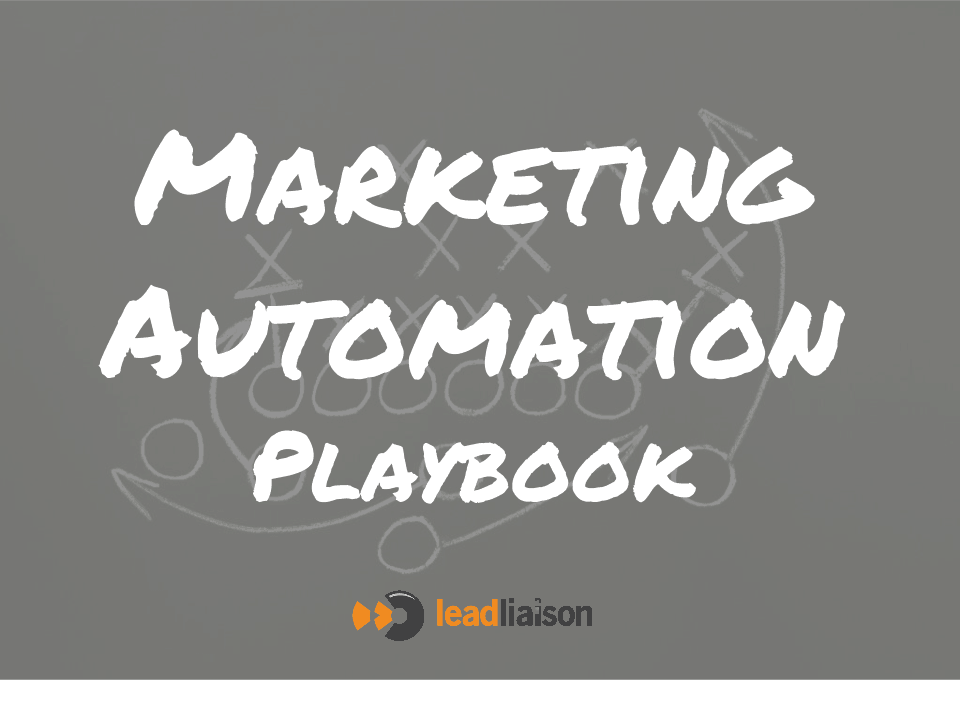Growth Marketing Software Stack for B2B Companies
Growth marketing software has commonly been referred to as a strategy that focuses on the entire funnel, as opposed to the top, middle, or bottom. Small to mid-sized businesses and startups need to think out of the box and not expend precious cycles trying to mimic traditional sales and marketing methods.
At Lead Liaison, we didn’t know about many of these solutions when we first started. Over time we either purchased these solutions or built them ourselves. Most of our growth marketing needs have manifested themselves as software that we’ve created to address a specific need in the overall growth marketing strategy. In addition to our own software, we’ve been using solutions from other providers to build what we feel is the ideal growth marketing software stack. One key aspect of this ultimate growth marketing software stack is that every single solution in the stack is web-based. All your team needs is a web browser and you’re up and running!
We adopted a growth marketing strategy in the early stages of our business; however, the stack wasn’t built overnight. It’s taken many years to put together this growth marketing stack. We hope you’ve coveted an article like this as it’s not easy to identify an ideal growth marketing stack. It’s our pleasure to present this stack to you in the hope that it helps your company either get up and running quickly or accelerate faster.
Here it is:
- Top of the Funnel: Rhythms™, Lead411, ZoomInfo
- Middle of the Funnel: Lead Management Automation (LMA)™
- CRM: OneFocus™
- Business Operations: Google
- Sales Research: LinkedIn, Owler, Datanyze, BuiltWith
- Task Management: OneFocus™, Trello, Google
- Support & Help: Screencast-O-Matic
- Communication: Slack, Dropbox
- Product Management: Atlassian Jira
- Customer Documentation: Atlassian Confluence
- Finance: Quickbooks Online
Each of these solutions and their benefits are explained below. We break up the growth marketing software stack into two parts, sales and marketing and operations.
Growth Marketing Software Stack:
These solutions benefit the sales and marketing teams. For most companies focused on growth marketing, their sales and marketing team will be less than 10 people. These solutions are highly effective and affordable, whether you’re a funded or bootstrapped growth marketing company this is the way to go.
- Top of the Funnel: Rhythms™, Lead411, ZoomInfo, Hunter, MailTester.com, FullContact, Clearbit. Perfecting sales isn’t that difficult. It’s about establishing a process to see what works, then rinse and repeat. Sales can be systematic too. We use Rhythms™, which help our sales people get into a groove (dare I say rhythm) with their sales. It helps them establish an outreach plan, that’s ideal for business development reps or seasoned account managers. Reps add manual emails, auto-emails, phone calls, postcards, handwritten letters, and various tasks into a plan – giving them a blueprint for sales. When new reps come aboard they can easily adopt your company blueprints. It helps to feed Rhythms™ with fresh contacts. We like Lead411 for email-only contacts and ZoomInfo for higher quality data. ZoomInfo has the highest concentration of contacts with phone numbers and emails out of all providers we’ve found. This makes ZoomInfo the best solution for high-touch sales plans or account-based marketing. Your growth marketing strategy should be focused on quality over quantity though. Gone are the days of batching and blasting emails. That’s a quick way to sink your growth marketing ship. Spend more time researching and reaching out to each contact you pull from your source. Rhythms™ will help you achieve high quality sales campaigns. Hunter and MailTester.com help round out the prospecting solution to verify email addresses. Teams might also find FullContact and Clearbit useful for finding contact information.
- Middle of the Funnel: Lead Management Automation (LMA)™. Once you develop your top of the funnel leads into engaged contacts they need to be nurtured and followed up with. Although some providers call these solutions “marketing automation”, we’re not a fan of that phrase. Marketing automation is a strategy really, and not software. There is software to better manage leads though. Qualifying, nurturing, prioritizing, and engaging leads are some of the benefits of lead management software. In addition, software like LMA comes with a suite of marketing tools such as an email, form, landing page builder, social posting and more.
- CRM: OneFocus™™. Don’t waste your time on expensive and bloated CRMs such as Salesforce.com and Microsoft Dynamics. These platforms are great for large enterprises, but if you’re reading this article and care about growth marketing software – then you won’t be interested in those CRMs anyhow. We might be a bit biased here, but we created OneFocus™, for companies like us that are focused on growth marketing. We didn’t need all the fat around the bone, we just needed the essentials of a CRM. Deal, task, contact, company management was all our sales team needed with an easy to use interface. They go it with OneFocus™. Other companies can also enjoy this light-weight CRM as it’s 100% free.
- Sales Research: LinkedIn, Owler, Datanyze, BuiltWith. As your sales team scours the market for opportunities or finds new leads with ZoomInfo or Lead411, they’ve got to be researched further. Datanyze and BuiltWith have some nice plugins (our favorite is Datanyze) that help you visit a prospective company’s website, click the browser plugin icon, and all the company firmographics, social info, and technographics (what technology they use) is right there at your disposal. Owler is mainly useful for finding a company’s competitors, while LinkedIn helps you learn more about the Prospect.
- Task Management: OneFocus™, Trello. There are 100s of task managers out there. Our two favorites are Trello and OneFocus™. Trello is a nice looking web application that’s very easy to use. Users can create different boards with tasks in the boards and share boards with each other. To complete tasks, users drag and drop tasks from one stage to another. Trello is great for general tasks and to-do items (even for personal tasks); however, OneFocus™ is ideal for sales and marketing tasks as it’s fully integrated into Rhythms™ and OneFocus™, solutions for the top of the funnel and general lead management. OneFocus™ has a slick task manager and task wizard making it easy for reps to make the most out of their day while staying organized and focused.
Growth Marketing Software (Extended):
We put this part of the growth marketing software stack together as these solutions complement the sales and marketing stack. Some of these solutions such as Screencast-O-Matic are lesser known, but super handy and affordable for sales, marketing, and support.
- Business Platform: Google. Most companies go one of two routes here, Microsoft or Google. Many companies “think” they need Microsoft and still think of Google as a solution for personal use. When in fact, they couldn’t be more wrong. Google has a killer stack, which they call G-Suite. It is jam packed with value and around $5 per user per month. It includes Gmail (email), Docs (like MS Word), Sheets (like Excel), and Slides (like PowerPoint), and Drive (like Dropbox). For those that think they can’t live without Outlook, with a few tricks in Gmail, you can make it look like Outlook. Docs and Sheets are amazing. They allow companies to create Templates, making it easy to create sales and marketing material on the fly, that all looks has a common look and feel – for example, Order Forms, Master Subscription Agreements, Mutual NDAs, Addendums, and more. Try G-Suite, once you get used to this platform you won’t look back. Oh – and it’s backed by Google!
- Support & Help: Screencast-O-Matic. This has been our little gem. For less than a meal at Denny’s, you get an easy to use screen recording software that instantly uploads videos to their cloud service (no extra charge) or YouTube (unlimited). We use Screencast-O-Matic to record help videos during the sales and support process. In seconds after a recording your video can be send to a cloud service of your choice and a link can be emailed. Sending links is so much easier than sending large files across the internet.
- Zoom: Conferencing and screen recording. We used to use GoToMeeting until we got fed up with the quality and price. Zoom is much more affordable, gives us instant recording options with the ability to easily screen share from our mobile device (great for mobile apps) at half the price of GoToMeeting with better quality.
- Communication: Slack, Dropbox. Slack is by far our favorite tool for communication. Prior to Slack we were using Google Hangouts on the sales side and Skype with vendors and contractors and some employees. It was a pain context switching between apps, all with different interfaces. Slack is the most amazing and modern communication tool we’ve seen. It’s ability to integrate with other sales and marketing apps to strengthen your growth marketing stack is unprecedented. Some of our favorite integrations include Jira Cloud, Google Drive, Giphy, and Dropbox. Dropbox is like a hard drive in the cloud for your company. It’s a nice interface and easy way to manage sharing documents across your organization.
- Product Management: Atlassian Jira Cloud. Jira is used for managing product roadmaps, bugs, new features, and more. Product Managers and engineering teams can use Jira to run engineering sprints (short periods of work prior to a software release) and track overall progress.
- Customer Documentation: Atlassian Confluence. Confluence is a cloud-based documentation platform. Use it to create different “spaces” for your organization. For example, customer documentation, employee handbooks, and corporate wikis to document process. Open your customer documentation up so you don’t require a password. That way you can easily send out links to your docs and user manuals.
- Finance: Quickbooks Online. QuickBooks is an easy to use system to manage your books, create reports, track income and expenses. Most growth marketing software companies care hire someone part time for bookkeeping, outsource it, or give this to one member of the team as it’s a part time task and not a full time job.
We hope you enjoyed our take on the ultimate growth marketing software stack. If you have any questions on the above software solutions don’t hesitate to ask, we’d love to help.








